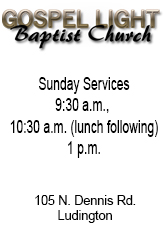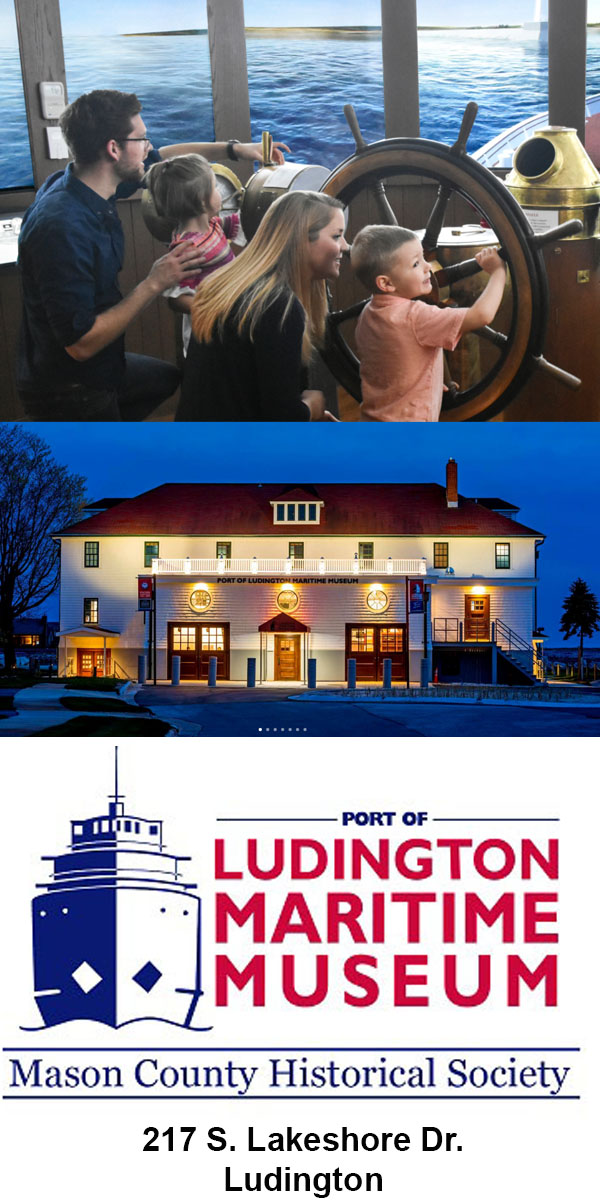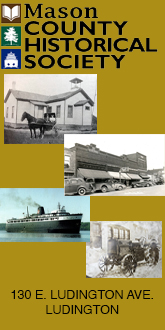
PM 18 on excursion in Chicago

By Rob Alway, Editor-in-Chief
The worst disaster to ever strike the Ludington-based carferry fleet occurred on Sept. 9, 1910 when the S.S. Pere Marquette 18 sunk 20 miles southeast of Sheboygan, Wis., resulting in the death of 29 people.
History will rank it as the second worst carferry disaster on Lake Michigan and the third worst on the Great Lakes.
Many articles, and even some books, have been published about the PM 18 disaster. The sinking made headlines again in 2020 when divers found the ship’s remains off the shore of Sheboygan. This article is the beginning of a series that will tell the story of the Ludington-based carferries with an emphasis on the people who worked on the boats.

F&PM locomotive at the Ludington roundhouse
Mason County Historical Society collection
The Flint & Pere Marquette Railway
The Flint & Pere Marquette Railway was incorporated on Jan. 21, 1857 and ultimately owned 170 miles of railroad from Flint to Ludington. The creation of the railroad was the result of $3,775,000 land grant signed by President Franklin Pierce in 1856 designed to help build several railroads in the Upper Peninsula and four in the Lower Peninsula. As part of the land grant, the railroad was expected to complete 20 miles of track each year. The initial tracks were built between Saginaw and Flint. The Flint & Pere Marquette Railway reached Ludington in 1874.
In Mason County, the railroad also included a northerly spur that terminated in Manistee. The F&PM was instrumental in the development of many towns along its route. In Mason County those towns included Walhalla, Custer, Scottville, Tallman, Fountain, Free Soil, and Ludington.

The John Sherman
The beginnings of the Ludington cross lake steamers
Within a year of the railroad reaching Ludington, the F&PM was interested in break-bulk steamer service across Lake Michigan. Break-bulk steamers carried railway freight from shore to shore. Railcars at that time did not travel across the lake, so the contents of the cars were removed, loaded onto the break-bulk steamer, shipped across Lake Michigan, then re-loaded onto railcars waiting on the other shore.
The F&PM chartered the 175-foot-long side wheeler steamer John Sherman to shuttle grain, packaged freight and passengers between Ludington and Sheboygan, Wisconsin to connect with the Sheboygan & Fond du Lac Railway. The railroad was apparently interested mainly in eastbound grain movements, but the steamer also handled passengers and general cargo.
The John Sherman was built in 1865 for the United States Revenue Cutter Service. It was originally called the USRC John Sherman and was used on Lake Michigan by the federal government until it was disposed of in 1872 and sold to a buyer in Cleveland. It was then sold in 1873 to the company River & Lake Shore. After serving the F&PM for one year it was rebuilt as a passenger steamer and operated out of Detroit.
The John Sherman was too small for the needs of the F&PM and served only for a single season. It was sold to J.P. Clark and W.O. Ashley of Detroit in 1878 who removed the engines and placed them initially in the boat Alaska and then, in 1890, they were placed in the boat Frank E. Kirby. The Sherman was turned into a lumber barge until it was scrapped in 1893.
Beginning in 1876, the railroad chartered a variety of steamers from the Goodrich Transit Company, the largest Lake Michigan passenger and package-freight carrier. The Goodrich ships operated at various Wisconsin ports, but the principal route in connection with the Flint & Pere Marquette came to be the run from Milwaukee to Ludington, Manistee and Frankfort.

City of Ludington
One of Goodrich’s most notable propellers, the City of Ludington of 1880, was built for this route. The 180-foot-long City of Ludington was built in 1880 by the Burger Boat Company, operating as Rand & Burger Shipyard, in Manitowoc, Wis.
The F&PM ended its relations with Goodrich transit in 1883 and purchased two steamers for its own operation out of Ludington, F&PM Nos. 1 and 2. Both were typical Great Lakes propellers at the time, with their engines aft and a single tier of cabins for 25 passengers on the spar deck. A spar deck is the upper deck of a ship that extends from stem to stern
The F&PM boats were schooner-rigged and were equipped with reinforced hulls for winter operation. Their one unusual characteristic was having their boilers on the main deck, so as to leave their holds free for eastbound train movements.

Flint & Pere Marquette No. 4. Mason County Historical Society collection.
With an increase in traffic in the late 1880s the railroad expanded its fleet by three ships: F&PM Nos. 3, 4, and 5, built in 1887, 1888, and 1890, respectively. Nos 3 and 4 were break-bulk and passenger steamers, similar to the original pair, but larger. No. 5 was a 226-foot package freighter, built without passenger accommodations. It was intended mainly for winter flour movements across the lake.
The first railroad to offer carferry service across Lake Michigan was the Toledo Ann Arbor & North Michigan Railway, predecessor of the Ann Arbor Railroad.
The Toledo Ann Arbor & North Michigan was formed by James M. Ashley, former Governor of Montana, in 1884. It reached Frankfort in 1892. Predecessor companies had built north from Toledo beginning in 1870. The line reached Copemish, 267.5 miles from Toledo, in 1888. The following year, an independent road promoted by local interests, the Frankfort & South Eastern, reached Copemish from Frankfort — 23.5 miles — completing the line from Toledo to Frankfort. In 1892, Ashley acquired the Frankfort & South Eastern, bringing the entire line under TAA&NM management.
Frankfort had been an important port in the lumber trade for some years, and package freighters called there both in cross lake and coastwise service. Its harbor, Betsie Lake, is connected by a short channel to Lake Michigan. The harbor is extremely snug, offering protection against storms. Since the harbor mouth is quite far out into Lake Michigan, it is not troubled with concentrations of pack ice to an exceptional extent.
Almost immediately upon taking over the Frankfort & South Eastern, Jan. 8, 1892, the Toledo Ann Arbor & North Michigan began to operate break-bulk service across the lake to Kewaunee, Wis., the nearest major port on the Wisconsin shore. At this point in time, cross lake break-bulk service had been operating out of Ludington for 17 years.
The Lackawanna Railroad’s steamer Osceola made the first trip under lease to the TAA&NM. Osceola provided the service for the first season, along with the ships City of Marquette and Alice Stafford. Osceola could handle some 35 to 40 carloads of flour, the principle cargo, but the cost of transshipment amounted to $6 to $12 per car.
Ashley, even before completion of the railroad, had envisioned a service that could carry railcars across the lake to reduce the expenditure and to expedite the operation. He ordered a slip and other facilities built at Elberta, on the south side of Betsie Lake, across from Frankfort. He arranged with Frank E. Kirby to design a pair of wooden carferries, which were then built at the Craig Ship Building Company of Toledo. The keel of the first, Ann Arbor No. 1 was laid on June 10, 1892 and the ship was launched Sept. 29 of the same year.
Since the ship was the first of a new type, a carferry designed for lengthy trips on open water, it had many highly original features, some of which were successful and others of which were not. It had an oak hull, reported by those who sailed in it to have been particularly limber and flexible, and was steel sheathed to a point 4 feet above the water line. The new ship had a bow propeller for ice breaking and twin screws aft, making it the first triple screw ship in the American registry. It had three horizontal engines and three fire box boilers.

Ann Arbor No. 1. University of Detroit-Mercy Fr. Edward J. Dowling S.J. Marine Historical Collection.
The Ann Arbor No. 1 was 260.4 feet in length and 53 feet in width. It was 14.7 feet in height. The ship was designed to load at the stern with a car deck that was open aft, which was a potentially dangerous arrangement. There was a risk of the car deck being swamped by a wave. This would be a major topic following the sinking of the Pere Marquette No. 18 almost two decades later.

Robert Logan. MCHS collection.
The Ann Arbor No. 1 left on its first trip from Elberta to Kewaunee on Nov. 24, 1892.
Ann Arbor No. 2 was completed at the end of 1892 and made its debut in early January, 1893.
Other Kirby-designed ferries included the 215-foot wooden St. Ignace, built in 1888 by Detroit Dry Dock Co. for the Mackinac Transportation Co., the 288-foot wooden Sainte Marie, built in 1893 by Detroit Dry Dock Co., also for Mackinac Transportation Company in 1893, and the Shenango Nos. 1 and 2, which each entered service for the United States & Ontario Steam Navigation Company in 1895 and initially served on Lake Erie. The Shenango No. 2 was purchased by the Grand Trunk Milwaukee Carferry Company in 1898 and renamed the Muskegon. It was then purchased by the Pere Marquette Railway in 1901 and renamed Pere Marquette 16.
The evolution for the F&PM was obvious. The railroad began lengthy negotiations with the Wisconsin Central Railway toward the end of establishing a through all-rail route via Ludington and Manitowoc. The arrangement required the Wisconsin Central to build a branch from its main line at Neenah-Menasha, near Lake Winnebago to Manitowoc.

Pere Marquette (later Pere Marquette 15). MCHS collection.
In December, 1895, the F&PM ordered a steel carferry, designed by Robert Logan (1861-1918), a prominent naval architect of Cleveland who had immigrated to the U.S. from Scotland. Logan’s original plan called for a four-tracked steel steamer of 337 feet with twin screws aft and, like all six of the wooden ferries that preceded her, a bow propeller. Apparently on the basis of the Ann Arbor’s unsatisfactory experience with bow propellers, the Flint and PM dropped the forward screw from the plans before the ship was built. The plans were also altered to cut back her spar deck slightly, as on modern carferries, rather than to have it extend all the way to the stern, as on the original Ann Arbor ferries.
The Pere Marquette was launched on Dec. 30, 1896 and arrived in Ludington on Feb. 13, 1897. It was then sent to Milwaukee for inspection. The ship had twin screws, steel hull, two stacks placed fore and aft and a single deck of cabins.
The Pere Marquette made its maiden voyage from Ludington to Manitowoc the evening of Feb. 16-17, 1897. It carried 22 freight cars and the private car of S.T. Crapo, general manager of the Flint & Pere Marquette Railway.
Prior to the arrival of the Pere Marquette, the F&PM sold the F&PM No. 1 in April, 1896 to Hurson Transportation Co. for night service between Chicago and Milwaukee. In 1898, the railroad added to its fleet’s passenger capacity by having the F&PM No. 5 rebuilt with passenger cabins for Ludington to Milwaukee service.

PMRR switcher unloading PM 17 in 1926, Ludington.
MCHS collection
The Pere Marquette Railway
The Pere Marquette Railway was formed on Nov. 1, 1899 to consolidate the Flint & Pere Marquette, the Chicago & West Michigan and the Detroit Grand Rapids & Western. William Crapo, president of the F&PM, was named chairman of the board, Charles M. Heald, president of the C&WM, was named president. Stanford T. Crapo, son of William Crapo, was named general manager. Operations of the railroad began Jan. 1, 1900.
During the first four years of its existence, the PMRR acquired several independent railroads that were built in the 19th century. It also built some new lines.
 The Pere Marquette carferries
The Pere Marquette carferries
When the new company was formed, it also obtained the former F&PM fleet consisting of the carferry Pere Marquette and the passenger and break-bulk freight-carriers F&PM Nos. 2, 3, 4, and 5. Additionally, it acquired a carferry that had been owned by the Detroit Grand Rapids & Western.
In 1897, the DGR&W had leased the Shenango No. 2 from the United States & Ontario Steam Navigation Company. The 282-foot-long ship was built in 1895 by Craig Ship Building Co. in Toledo and served on Lake Erie until it was put in service between a new slip on the Chicago & West Michigan at Port Sherman on the south bank of the harbor mouth in Muskegon and another on the Milwaukee Road at Maple Street in Milwaukee. It began its Lake Michigan service on Dec. 27, 1897. The DGR&W purchased the ferry in 1898 and renamed it Muskegon. In 1900, Pere Marquette Railway relocated the Muskegon to serve a Ludington to Milwaukee route.
The move was part of the PMRR’s consolidation of services, moving its entire eastern Lake Michigan ferry service to Ludington. This was done with the philosophy that when more ships move in and out of a harbor in winter months, it is easier to maintain a channel through the ice. A single terminus on the east side of the lake was preferable to two. Pack ice formation is more severe on the east side of the lake than the west side, which meant having several western ports did not pose as much of an issue. Additionally, dispatching out of a single eastern terminus offered the railroad a higher degree of flexibility than is possible with two terminals.
In 1901, the Pere Marquette Railway changed the names of its entire carferry fleet, including its Detroit River ferries. Break-bulk freighters were to be numbered 1 and up. The river ferries were to be numbered from 14 downward and the Lake Michigan ferries were to be numbered 15 and above.

PM 12 on Detroit River.
University of Detroit Mercy – Fr. Edward J. Dowling, S.J. Marine Historical Collection
The break-bulk freighters were renamed Pere Marquette 2, 3, 4, and 5. The Pere Marquette was renamed Pere Marquette 15 and the Muskegon was renamed Pere Marquette 16. To this day, the ferries are normally referred to using the abbreviation PM rather than the entire name Pere Marquette.
PM 15 continued service until 1930, when it was laid up in Ludington. There it remained until it was scrapped in Manitowoc in 1935. PM 16 was laid up in 1907 and, in 1917, sold to Peter Edwards of Sault Ste. Marie, Mich. who sold it to the Hammermill Paper Co. of Erie Penn. Its name was changed to Harriet B. on March 21, 1918 and its superstructure was cut down so it could be used as a barge. It sank on May 3, 1922 near Two Harbors, Minn.
The Pere Marquette Railway ferried about 27,000 cars in 1900 and about 75,000 1904. The railroad ordered four more steel ferries, all designed by Robert Logan, similar, but not identical to PM 15. Mechanically, they differed mainly in having triple expansion engines.

PM 16.
UD-M Dowling collection
All four of the new ferries came from American Ship Building. They were all 338-feet-long, 56-feet-wide and 19.5-feet-high. They each had four tracks and could carry 30 cars. They had two triple expansion engines. PM 17 came from its Cleveland works in 1901, the first ferry bought new by the PM. It had a full length cabin with more extensive passenger facilities than her predecessors.

William Mercereau. MCHS collection
PM 18 was launched at the same place the following year. It was sponsored by Beatrice Logan, daughter of the designer, who used the picturesque Japanese custom of releasing doves as the ship went down the ways, instead of christening her with wine in the orthodox western fashion. The new ship was very similar to PM 17 but was equipped with more passenger space. It had 50 cabins and additional berths for a total of 250 passengers. It was put in service at the beginning of the winter of 1902-1903. The PM 18 was dubbed as the fleet’s flagship.
PM 19 followed in 1903, the same size as the 17 and 18. It was launched at Lorain in October, sponsored by Lulu Mercereau, wife of William L. Mercereau, the PM’s superintendent of steamships. The new ferry was essentially a duplicate of PM 17, except for an absence of passenger accommodations. The railroad envisioned having regularly scheduled sailings which would carry passengers, and various unscheduled sailings as traffic demanded. It hoped to use three boats regularly on the Milwaukee run, one to Manitowoc, and the rest to be assigned as traffic demanded. Service was extended to Kewaunee late in 1903. PM 20 was identical to PM 19 and built simultaneously at American’s Cleveland yard. The two were the first actual sister ships built for the PM. Both were equipped with split cabins in the fashion of the original PM. The four new ferries differed from one another only in passenger accommodations and in engine details.

Capt. Peter Kilty
Captain Peter Kilty
Captain Peter Kilty was considered the senior carferry captain in 1910. He had worked for the Ludington ferries since May 20, 1898 when he took command of the Pere Marquette (later known as the Pere Marquette 15), a year after the PMRR’s first carferry began service across Lake Michigan. Two years prior, Kilty was captain of the Toledo Ann Arbor & North Michigan Railway’s Ann Arbor No. 1, which began service in 1892, giving Kilty the distinction of being in command of two legendary carferries: The wooden AA No. 1 was the first cross lake carferry and the PM was the first steel cross lake carferry.

Mary “Lizzie” Kilty
Peter Kilty was born in January 1860 in St. James, Beaver Island in what is now Charlevoix County, the son of Irish immigrants Patrick Kilty (1813-1900) and Mary (McCarthy) Kilty (1825-1900). He was a young boy on the island when James Jesse Strang of the Church of Jesus Christ of Latter Day Saints, and his followers, formed their settlement on the island. Strang later declared himself king of his church, and by default, leader of the island — a declaration that didn’t go so well for the non-followers. He was elected to the Michigan House of Representatives, but that didn’t protect him from his enemies. He was assassinated in 1856 in broad daylight by two former followers, who each received small fines for their crime.
Patrick and Mary Kilty had five children: Margaret (1851-death unknown), Sarah (1856-1894), Peter (1860-1910), Marry “Minnie” (1862-1942), and Anne (1863-1944). The children were all raised on Beaver Island.
From about the age of 16, Peter found occasional employment on schooners.
About 1880, Peter Kilty married Mary McCarthy (1825-1900) in Elk Rapids. They had four children: Alfred (1881-1948), John Peter (1882-death unknown), Claude P. (1887-1948) and Mary Elizabeth (later Tripp, 1889-1979).
The family moved to Onekama where Peter began working on fishing tugs. In 1889, he skippered a fishing tug. Also that year, he became a mate on the passenger boat Adrienne (also spelled Adrian) based out of Onekama. The boat made trips between Manistee and Onekama.

John D. Dewar docked in Pentwater. UD-M Dowling Collection.
In 1892, he was named captain of the John D. Dewar passenger steamer. The 72-foot boat was built in Ludington in 1885 by A. Betters. Its original owner was Duncan Dewar of Ludington. Over its lifespan it had at least 10 different owners. When Kilty was skipper, it was owned by the Frankfort and Manistee Steamboat Line, and carried passengers and freight between Frankfort and Manistee with stops in Watervale, Burnham, Arcadia, Pierport and Onekama. From the late 1800s until 1906, the boat sailed along the lakeshore making one round trip daily. After 1906, the boat operated between Ludington and Pentwater when the Frankfort and Manistee Line was purchased by the Pere Marquette Line Steamers (the company that had purchased the Pere Marquette’s original break-bulk freighters, known as the “black boats”). It was later replaced by the PM 6 and sold to a Chicago company. It later burned.
On either Sept. 19 or 20, 1921, the boat was being towed to Sturgeon Bay by the tug Silver Spray for repairs and a rebuild when it sprang a leak and sank behind the Milwaukee breakwater. The boat’s engine and boiler were salvaged and the hull destroyed.

The Petoskey
In 1893, Peter Kilty became mate on the S.S. Petoskey, a passenger steamer that made trips between Chicago and northern Michigan. He served on the Petoskey for six years.
Steamships like the Petoskey were the main form of transportation to northern Michigan from Chicago in the days before automobile travel was more common and roads were more accessible. There wasn’t a direct railroad from Chicago to most of northern Michigan.
Among the passengers who used such ships were Dr. Clarence “Ed” and Grace Hemingway. In 1898, the Chicago-area residents purchased a cottage on Walloon Lake in Emmet County, a year before the birth of their first son, Ernest. The Hemingways would take steamer ships to their summer home. By that time, however, Kelty had moved on.
The wooden steam screw Petoskey was built at Manitowoc in 1888 at the Burger and Burger shipyard. Its home port was Grand Haven. The vessel had diagonal steel straps, an iron lined boiler house and a steam windlass. It originally ran from Chicago to Traverse City, Petoskey and Harbor Springs.
The Petoskey burned in the shipyard of the Sturgeon Bay Shipbuilding and Dry Dock Co. on Dec. 3, 1935. The fire, which was discovered about 8 p.m., may have been caused by sparks from acetylene torches being used in the modification of another ship in the yard, the E.G. Crosby a steel steamer being cut down for use as a barge. The fire eventually spread to four other ships before being brought under control. None were insured. The five destroyed vessels were: the tug Beaver, the schooner Lucia A. Simpson, the steamer Swift and the steamer E.G.Crosby.

Ann Arbor No. 1
On Feb. 12, 1896, Kilty became captain of the S.S. Ann Arbor No. 1, based out of Frankfort/Elberta.
The 260-foot-long wooden Ann Arbor No. 1 was the first ferry built to carry railcars across Lake Michigan. It was designed by Frank E. Kirby and built at the Craig Ship Building Company of Toledo. It made its first trip on Nov. 24, 1892 between Frankfort and Kewaunee, Wis. Less than two months later, the Ann Arbor No. 2 entered service.
Ironically, the Ann Arbor No. 1’s demise occurred the same year as the PM 18. It caught on fire in Manitowoc on March 8, 1910. The wooden ship’s hull was recovered and reduced to a barge.
Peter Kilty was well respected as senior captain of the PM fleet.
“Capt. Peter Kilty, the master of No. 18, is in every sense of the word a fit man for the command of the Pere Marquette flagship,” a March 10, 1904 Ludington Record Appeal article, No. 18 – The ‘Flagship” and her Master” states. “His worth is appreciated, not only by the employing owners, but by every man connected with the line as well. Everything about the man is in his favor, temperament, judgement, record, loyalty — these and other like qualities unite to mark Capt. Kilty a conspicuous man among men, a commoner yet a prince, the acknowledged peer of a rising generation of carferry navigators. No man in the line is more respected, more looked up to, or more universally popular than the modest, agreeable, gentlemanly skipper of the flagship.”
 The wreck of the Pere Marquette No. 18
The wreck of the Pere Marquette No. 18
Rail traffic was heavier in the winter months. For this reason, the railroad did not need as many ships in the warmer months. Because the PM 18 had the most ample passenger accommodations it was frequently chartered to excursion operators in the summer months. For the July 4 weekend in 1903, the PM 18 ran out of Chicago for the Chicago & South Haven Steamship Company, and for the entire summer seasons of 1909 and 1910 it ran between Chicago and Waukegan for the Chicago Navigation Company. The carferries lent themselves to the excursion trade quite well. The Chicago Navigation Company planked over the main deck for dancing, and installed slot machines for amusement.
At the end of May, 1910, the PM 18 was removed from its regular cross-lake service and started its excursion service in Chicago. It finished that service on Labor Day weekend and on Sept. 7 it returned to Ludington at 6 p.m. Newspaper accounts from that time stated that the PM 18 had undergone several inspections while it was operating out of Chicago, the last being made the week of its departure for Ludington. It had been found to be in excellent condition by the government inspectors.
Upon its arrival in Ludington, scrubbers and cleaners went aboard to complete preparing it for service. This included reconverting the car deck, which had been covered up so it could be used as a dance floor.
The 18 was filled with coal, loaded with 29 freight cars, nine passengers — including two stowaways — and a crew of 52, which counted a number of scrubbers and cleaners who were still aboard to help complete the transition from the excursion season.
The ship set sail for Milwaukee at 11:40 p.m. on Thursday, Sept. 8. For the first few hours nothing unusual was reported. At 3:30 a.m., however, the first indication of the impending disaster arrived on the bridge when First Assistant Engineer C.L. Rosencrans reported to First Mate Joseph Brezinski that the vessel was taking water. The ship was about mid-lake when an oiler went aft from the engine room into the flicker to oil some bearings on the propeller shafts.
The unlicensed crew was housed below the car deck. Their social room aft the engines was known as the “flicker,” apparently because of the flickering of the 25-cycle electric light with which it was illuminated. To this day, that area is still referred to as the flicker on the S.S. Badger.
The oiler had discovered that the ship had taken a great deal of water, and that there were some seven feet in the aft compartment. He reported immediately to the engineer, who in turn notified the bridge. First Mate Brezinski found a starboard deadlight broken in the flicker and assumed that was the source of the water.
A deadlight is a shutter fitted over a porthole, that can be closed in bad weather to keep water out and discourage the glass windows from breaking.

Some of the PM 18 officers, march 15, 1910. From left to right: Wheelsman Simon Burke, Second Mate Walter Brown, Capt. Peter Kilty, First Mate Joseph Brezinski. Burke survived. Photo from Mason County Historical Society collection.
Simon Burke, a wheelsman, was one of the survivors. Burke had come on duty at 12:30 a.m. and said later that Brezinski immediately notified Capt. Peter Kilty who rushed to the pilot house so he could assess the situation.
The crew closed the deadlight and started the pumps, but the water gained on the ship. The stern settled markedly, enough so that some port deadlights in the flicker gave way, bringing in more of the sea.

PM 18 on excursion in Waukegan, Ill.
There was a strong north wind blowing that night and the white caps were breaking over the car deck. Capt. Kilty changed the ship’s course to the south to ease the condition.
For the next 40 minutes the PM 18 struggled down Lake Michigan as crewmen battled to keep it afloat. Throughout this time, no one, at least none of the officers, thought the PM 18 was in any immediate danger. It had taken considerable water in other storms and had no problem in keeping the vessel in a safe condition.
At 4:10 a.m., the situation had worsened considerably with the water still pouring in and the ship beginning to settle at a faster rate. Cap. Kilty ordered the ship to make for the Wisconsin shore directly. At the same time he ordered the engines slowed. Five minutes later, Capt. Kilty considered the condition of the ship to be sufficiently serious enough to summon all hands.

Schematics of the PM 18
“I do not know why they slowed (the engines) and I asked several people including the first mate and he said he didn’t know,” wheelsman Simon Burke said. I believe everyone thought we would pull through.”
Purser Stephen F. Sczepanek began to send the CQD distress signal by radio at 4:15 a.m.
CQD was a distress signal used by wireless operators and telegraphers to signal “all stations, distress”. It was created in 1904 by the Guglielmo Marconi wireless company by adding the letter “D” to the signal “CQ”, which means “seeking you” or “all stations”. Although it was commonly used, CQD was never adopted as an international standard because it could be confused with the general call “CQ” in poor reception. It was also considered outdated and confusing, and was eventually mostly replaced by the SOS signal in 1905.

The RMS Titanic used CQD in its first distress call after hitting an iceberg in April 1912. The call was repeated six times before the ship provided its position.
“17-17-17-18 — come help, come help,” was one of the messages Sczepanek sent out, according to transcripts of the distress calls published in “Steel on the Bottom” written by Frederick Stonehouse.
In an April 7, 1958 Ludington Daily News article, Rose D. Hawley of the Mason County Historical Society, recalled the tale of survivor George Harwood (1892-1975). Harwood, of Ludington, was 17-years-old and was hired as a scrubber on the ship. It was his first — and last — trip as an employee of any ship.
Harwood said the first alarm that something was wrong came around 4:30 a.m., Sept. 9.
“Everyone on board. Ship sinking.”

PM 18 in Chicago (mislabeled on photo as Pere Marquette)
Harwood and his cabin mate, George Truedell (1887-1933), a pantryman, donned their trousers and went out on deck, Hawley wrote. They were ordered to the car deck to help push off some of the loaded cars.
“Harwood was homesick and scared to death,” Hawley wrote. “He did not feel he was of much help there (on the car deck) so he went up to the galley where the cooks were making hamburgers for everybody. The smell nauseated him so he went out and helped get a yawl into the water. Then he found a jog in a cabin wall and stood there out of the way.”

PM 18 entering Ludington harbor
“Seymour Cochrane, a Chicago businessman who had just delivered the No. 18 back the P.M. Railroad Co., after using it at Chicago for an excursion boat all summer, had a large quantity of money in bills and silver with him and fastened the bills around his belt. The silver was in several bags and he threw the bags down on the deck and called out ‘Anybody can have it that wants it.'”
Harwood recalled seeing Marion Turner, a stewardess, also described as the maid, with her possessions around her kneeling on the deck, her fingers entwined in her Rosary.
“She refused to give anything up or to jump when the order was given, so she was lost,” Hawley wrote.
Chief Steward Frank Young told a similar story to Harwood when he was interviewed by Paul S. Peterson, managing editor of the Ludington Daily News for a Nov. 10, 1973 article.

Capt. Kiley and E. Ross Leeham, chief engineer of PM 18.
“I had been asleep in my cabin when I was awakened by one of the crewmen who told me to come on deck,” Young said. “I looked at my watch it was quarter after four. I felt that something serious must be the matter or Capt. Kilty would not have roused us. I dressed hastily and went down the after stairway to the car deck. At the time water was washing up on the car deck as far as the foot of the stairs. I went and got my boys (steward’s department) together and sent them down to assist in shoving freight cars overboard but the captain thought he had all the men he needed.”
Like the other survivors, James Bartholomew Fahey (1877-1958) also recalled the day’s events later in life. Fahey was a cook on the ship and also a friend of Capt. Kilty. He was even a pallbearer in Kilty’s funeral.
Leahy’s story, written by Leonore P. Williams, was published in the Jan. 24, 1957 Ludington Daily News.
“It was about 4 a.m. when a man aroused me,” Leahy said. “I don’t know how long the water had been coming in but by that time it was within a foot of the car deck of the ship. No one was too alarmed at that time as the engines were running and it did not seem possible that the 18 could sink. I hustled to the galley and made sandwiches and coffee for the members of the crew, all of whom were up and working to find where the water was coming in and try to check it.”
Capt. Kilty had ordered all of the freight cars be dumped over the stern in an effort to lighten the ship. The PM 18, like the PM 17, 19, and 20, could carry up to 30 cars. Somewhere between nine to 15 were jettisoned but some of the cars had become stuck. A forward seacock was also opened in an effort to equalize weight fore and aft. A seacock is a valve on the hull of a boat or a ship, permitting water to flow into the vessel.
Young said after ordering the ship to change course due west, Capt. Kilty came to the aft bridge to watch the attempt being made to rid the ship of the cars that were hung up.
“Finally, he ordered the boats lowered and all the boats on the port side were let down,” Young said. “Two men were put in each of these boats to keep them from knocking against the side of the ship as it rolled in the sea. Later another man was sent down to bail the water which splashed into them. These boats were let down just for an emergency.
“At various times I talked with the engineers and firemen and was informed that there was no water in either the engine room or the fire room. So long as this condition lasted I believed we would get out alright. Toward the last we were not making much headway, however, moving only about three miles an hour and the engines were slowed down.”

PM 17 in Ludington
George Hardwood described an elderly man who had offered some advice.
“‘Just keep your head boys, and you’ll be all right. This is my seventh shipwreck.’ It was his last one.”
“At 5:45 a.m. Chief Engineer E.R. Leedham came to the pilot house and asked how she was steering,” Simon Burke said. “He said then he felt the ship would pull through.
William L. Mercereau, Pere Marquette Railway superintendent of water lines, pursued a policy of dispatching ferries so that, whenever possible, two boats could be reasonably close in order to come to one another’s assistance in case of an accident. Pere Marquette 17 was the closest ferry, and proceeded immediately from Milwaukee to PM 18, sighting it at 6:30 a.m. about 20 miles off Sheboygan.

PM 17 entering Ludington harbor
Even at that time, Capt. Kilty and his officers thought they could make port at Sheboygan. The pumps were still working and the ship seemed to be getting no worse. The efforts to lighten her and equalize weight were thought to have been successful. At 7:15 a.m., PM 17 drew alongside PM 18 from starboard, but since that was the windward side, it could neither make fast nor come close enough to take off some of the passengers and crew. PM 17 put about and began an approach from the port side of the stricken ship.
The officers of the 18 thought they were winning their battle and therefore had neither ordered “abandon ship” nor even required that life jackets be put on the personnel aboard. Suddenly, the ship took an enormous amount of water, and sank almost immediately.
“Just then the order came, ‘Everybody jump,’ Harwood told Rose Hawley. He put one food into the anchor hole near him, turned around and fell off backwards into the water.
“As he struck (water) a suction pulled him deep into the water. The same kind of propulsion forced him back to the surface and shot him high up into the air. The ship had exploded almost instantaneously with the order to jump.”
Frank Young was able to get to a lifeboat that was still on the ship, but it was too late.
“About 7:30 a.m. I was standing on the upper deck aft of mid-ship. The ship gave a great lurch to port and I stepped into a lifeboat lying along side which was brought up to the level of the rail. At the same time I yelled to the man to cut the painter (rope). He picked up an axe and cut the line aft but before he could cut the line forward the ship sank taking the boat with it. I leaped into the water and was picked up with others who were floating with me on wreckage by a lifeboat from the No. 17.”
 Simon Burke recalled his last minutes of being on the ship: “A few minutes later the mate brought me a life preserver and said, ‘You may need one of these.’ Two minutes before she went down the lights went out. At that time I put on my coat and the water was already coming up the deck almost to the pilot house and I saw no use of staying there any longer. I put on the life preserver and jumped overboard. I went down a long ways and in another wreck I was in I went down 50 feet but the pressure then was nothing like I experienced when I jumped from the 18. I felt like I was stoved in. I came up alright and was picked up by one of the 17’s boats.”
Simon Burke recalled his last minutes of being on the ship: “A few minutes later the mate brought me a life preserver and said, ‘You may need one of these.’ Two minutes before she went down the lights went out. At that time I put on my coat and the water was already coming up the deck almost to the pilot house and I saw no use of staying there any longer. I put on the life preserver and jumped overboard. I went down a long ways and in another wreck I was in I went down 50 feet but the pressure then was nothing like I experienced when I jumped from the 18. I felt like I was stoved in. I came up alright and was picked up by one of the 17’s boats.”
James Fahey said he was on the bow of the ship before the 18 went down. He said the front of the ship seemed to be at least 75 feet up in the air.
“Somebody behind me hollered to jump and give him a chance,” Leahy said. “I jumped clear as the ship went down. My watch stopped at 7:20 so I suppose that was the time.”
The explosion was believed to have been caused by the compression of air in the hold. Wireless messages had been coming into Ludington since 4:30 a.m. and the last message was received at 7:30 a.m.
Pere Marquette No. 18’s stern went first, and Kilty was last seen on his flying bridge as it went down. The suddenness of her sinking plus the lack of preparedness of her crew took a toll with 27 dead.
PM 17 immediately put out boats to pick up survivors. With the high seas running, this was a difficult operation, and one boat was crushed against the ship’s own side, with a loss of life of two crew members. About 35 survivors were picked up, many of whom had been sucked down with the ship, but regained the surface in time to be saved.
The first rumor that the 18 had sunk was on the streets of Ludington at 6 a.m., 90 minutes before it actually went down, due to people intercepting Sczepanek’s messages from ashore. The wireless messages, however, did their job. In addition to the Pere Marquette carferries No. 17, the Pere Marquette No. 6 also responded. Both were joined by the tugs Reiss, Tessler, Welcome, Meyer and Ewig at the rescue scene.

PM 6 enterting Arcardia, Mich. harbor
The Pere Marquette No. 6 was a 130-foot-long break-bulk freighter that was originally owned by the Flint & Pere Marquette Railway. After the F&PM merged into the Pere Marquette Railway (1900), it sold its break-bulk freight, known as the black boats. In 1903, the Pere Marquette sold the black boats to Gus Kitzinger of Manistee, who started the Manistee Ludington & Milwaukee Transportation Company, a Michigan-based corporation. In September, 1903, W.S. Eddy of Saginaw, and his associates, purchased controlling interest in the company. The group was involved in the Michigan Salt Association. In 1904, they reorganized the line as the Michigan Salt Transportation Company, a corporation based in Wisconsin. Kitzinger remained general manager of the company. One of the primary commodities transported by the fleet, now known as the Pere Marquette Line Steamers, was barreled salt out of Manistee.
The Steamboat Inspection Service was unable to piece together an adequate explanation of the sinking. The original broken deadlight was too small to have admitted the seven feet of water into the flicker, nor could enough water have come in through other deadlights to swamp the ship. Two hypotheses were offered: either a seacock had been left open during the reconversion from excursion service, or the ship had taken water through some of the 18-inch scuttles on the car deck. No one who survived could explain why the ship took so much water so quickly in the last instants before sinking.
One of the more accepted theories is that a plate on the hull may have become loosened during the summer while the ship was carrying passengers on excursions out of Chicago. When the ship was loaded with 30 freight cars, 10 of them with coal, it went lower and water went into the breach. A loosened plate lapped over another might have cut its rivets making a larger breach, which would let in a flood of water.
An area of the ship that was under much scrutiny following the PM 18 disaster was its open stern — along with the open stern of every other carferry on Lake Michigan. The leaders of the Lake Michigan carferry companies met following the wreck of the 18 and all agreed to put sea gates on all their ships.

In 1911 the PMRR replaced the 18 with another ship by the same name. The new boat was the same length and width as its predecessor, 338 feet by 57.6 feet, but was slightly taller, 21.7 feet; the previous was 19.5 feet. Unlike the previous 18 and the 17, 19, and 20, which were built by American Ship Building Co. in Cleveland, the new 18 was built by the same company but in Chicago. It continued to serve the PM and later the C&O until it was retired in 1954. In 1957 it was sold for scrapping.
In 1977, a State of Michigan Historical Marker commemorating the sinking of the 18 was placed at Stearns Park. The marker remains and can be seen on the south end of the park along Court Street.
For years the survivors and their rescuers knew the approximate location of the final resting place of the The Pere Marquette 18. Cook James Fahey, in 1957, said it was in 500 feet of water, 16 miles east-southeast of the Sheboygan, Wis. pier head light. Leahy was pretty much correct. In 2020, the wreck was found by Minnesota shipwreck hunters Jerry Eliason and Ken Merryman who found the ship in 500 feet of water several miles offshore from Sheboygan and Port Washington, Wis. The ship sits stern first in the bottom of the lake bottom at a sharp angle, the top of the bow rising nearly feet off the lake bed.
“It’s pretty dramatic,” Merryman said in a 2020 interview with Minnesota Public Radio.
The stern of the wreck is embedded into the lake bottom at an unusually high angle with “a lot of wreckage laying around; there’s bathtubs, there’s two lifeboats laying on the bottom,” Eliason said.
The pilothouse structure broke loose when it sank and came to rest farther back, toward the stern; the roots of the cabins were torn off by escaping air as the ship sank.
The sinking of the PM 18 was the second worst carferry disaster on Lake Michigan and the third worst on the Great Lakes.

SS Milwaukee
Sinking of the Milwaukee
The 338-foot-long Milwaukee was built by the American Ship Building Co. in Cleveland in 1903 and was launched as the Manistique Marquette and Northern 1, operating for the Manistique Marquette and Northern Railroad, and operated from Northport to Manistique. It was commonly called the Manistique. In 1904 the railroad defaulted on an interest payment and went bankrupt. It then came under control of the Pere Marquette Railway which shut down the Northport dock and moved the ship to Ludington where it then operated from Ludington to Manistique, a 138 mile, 11 hour trip. The ship operated Tuesdays, Thursdays, and Saturdays from Ludington for two years.
Following the PM’s bankruptcy in 1905, the ship was returned to its original route, in 1906, between Northport and Manistique. In 1908, the MM&N Railroad was succeeded by the Manistique and Northern Railroad, which was partially owned by the Ann Arbor Railroad. The Ann Arbor had been running its Frankfort-based carferries to Manistique since 1898 and no longer had a need for a Northport dock.
The Manistique was sold to the Grand Trunk in 1908 and the name was changed to Milwaukee.
On Oct. 22, 1929, a northeast gale of 34 to 37 mph hit Lake Michigan. Storm warnings began at 8:30 a.m. The Pere Marquette ferries stayed in port. But, the Grand Trunk Milwaukee Carferry Company, based out of Grand Haven sent all four of its ferries out. Those ships included S.S. Grand Haven (built in 1903), S.S. Milwaukee (built in 1903), S.S. Grand Rapids (built in 1926) and S.S. Madison (built in 1927).

Milwaukee, left, and Grand Haven
The S.S. Grand Haven left Milwaukee at 2 a.m. and arrived in its namesake port 15 hours later at 5 p.m. (the trip normally took six hours).
The Milwaukee, under command of Capt. Robert McKay, arrived from Grand Haven to its namesake port about noon. McKay described the trip as fairly good. The Milwaukee took on 25 loaded railroad cars and left for Grand Haven just a little after 3 p.m. It passed Lightship 95 about three miles east at 3:45 p.m. and was seen to be rolling and pitching heavily. That was the last time anyone ever saw the Milwaukee. Unlike the Pere Marquette boats, the Grand Trunk boats were not equipped with wireless.
On Oct. 27, 1929 a Coast Guard patrol near South Haven picked up the ship’s message case which contained a handwritten note signed by A.R. Sadon, the Milwaukee’s purser:
“The ship is taking water fast. We have turned around and headed for Milwaukee. Pumps are working but sea gate is bent in and can’t keep the water out. Flicker is flooded. Seas are tremendous. Things look bad.”
There were between 45 to 53 crew on board. The Grand Trunk ships did not carry passengers. It has never been found.
In 1930, a new ship, replacing the Milwaukee, was built in Manitowoc. The SS City of Milwaukee began service in 1931 and served the Grand Trunk until 1978. It was then purchased by the State of Michigan and placed on loan to the Ann Arbor Railroad in Frankfort until 1981. It is now a museum ship located in Manistee, the last remaining early 20th century Great Lakes carferries.

Marquette & Bessemer No. 2
Sinking of the M&B No. 2
The 338-foot-long Marquette & Bessemer No. 2 was built in 1905 by American Ship Building Co. in Cleveland for the Marquette & Bessemer Dock & Navigation Co., which was a joint operation between the Pere Marquette Railway and the Bessemer & Lake Erie Railroad. The M&B took over operations of the United States & Ontario Steam Navigation Co. including the Shenango No. 1, which was the sister ship of the Pere Marquette 16 (which had originally been named the Shenango No. 2 and then later the Muskegon before joining the Ludington fleet as the 16).
On Dec. 7, 1909, the M&B No. 2 left Conneaut, Ohio at 10:25 a.m., loaded with 32 hoppers of coal, en-route to Port Stanley, Ontario. The storm brewing that day was considered the worst since a storm had hit Lake Superior in 1905. The ship never arrived. Three days later a lifeboat was discovered containing the bodies of nine crew members, all of whom had died of hypothermia. They were wearing life jackets but inadequate clothing to protect them from the cold. Between 30 to 32 died on the ship.
Ten months later, in October, 1910, the body of Capt. Robert R. McLeod washed ashore on the Ontario coast. The storm also took the crews of the freighters W.C. Richardson and Clarion, with a loss of 20 lives.
In addition to being ranked as the second-worst carferry disaster on the Great Lakes, and worst on Lake Erie, the M&B No. 2 also has the unfortunate honor of being the shortest-life of any Great Lakes carferry.
Interestingly, all three ships ranked as the three worst Great Lakes carferry disasters in history — the Milwaukee, the Marquette & Bessemer No. 2, and the Pere Marquette 18 — were nearly identical, each designed by naval architect Robert Logan and built at the American Ship Building Co. in Cleveland within a four-year time span. They were each about the same length with the same engines and hull design. The only major difference was the M&B No. 2 did not have passenger accommodations, which made more similar to the PM No. 19 and 20.
Cross lake carferry service on the Great Lakes began in 1893 with the Ann Arbor railroad ships based in Frankfort/Elberta. It began in Ludington four years later when the Pere Marquette made its maiden voyage between Ludington and Manitowoc. Dozens of ships carried railroad cars across the lakes. Today, only the S.S. Badger, built in 1953, remains in service as a remnant of the railroad ferry era, except it now only carries automobiles and passengers. Three major disasters in 131 years is an incredible record, especially considering the last disaster occurred in 1929.
 List of the dead
List of the dead
As reported in the Ludington Record Appeal, Sept. 14, 1910:
PM 18 Officers
- Peter Kilty, captain, of Ludington
- Joseph Brezinski, first mate, of Manitowoc
- W.H. Brown, second mate, of Ludington
- E.Ross Leedham, chief engineer, of Ludington
- Stephen F. Sczepanek, purser and wireless operator, of Worcester, Mass.
- Chalmer Rosencrans, assistant engineer, of Northport
- Paul Renner, second assistant engineer, of Ludington
PM 18 Crew
- Ole Bakken, wheelsman, of Ludington
- Samuel Bouchie, fireman, of River Bourgeois, N.S.
- Michael Haythaler, fireman, of Forestville, Mich.
- Peter Hire, watchman, of Ludington
- (Unknown first name) Jacobson, seaman, residence unknown
- Charles Jensen, oiler, of Ludington
- A.J. Mack, steward, of Westfield, NY
- Joseph Marlow, scrubber, of Ludington
- W. Parker, fireman, of Marine City
- John Schraufuagl, cook, of Chicago
- John H. Stone, lookout, residence unknown
- Marian Turner, cabin maid, of Ludington
- Frank Warner “Chicago Frank”, porter, of Chicago
- Two unknown crew: An oiler from Norway, and a fireman.
- PM 18 Passengers
- N.L. Bertrand, of Ludington
- W.H. Cummins, Webster, of Chicago
- Stowaways: Tom Kelly and brother, of Detroit
PM 17 crew
- Jacob Jacobson, scrubber, of Ludington
- Joe Peterson, watchman, residence unknown
List of survivors, as reported in the Ludington Record Appeal, Sept. 15, 1910:
PM 18 Crew
- Ray Anderson, deckhand, of Waukegan, Ill.
- Madison Andrew, deckhand, of Ludington
- Mike Bucholz, coal passer, of Ludington
- Simon Burke, wheelsman, of Cannes Cape, Briton
- Vanner Charlestown, fireman, of Buffalo, NY
- Stanley Chubb, first porter, of Ludington
- Grover Cooper, first porter, of Beardstown, Ill.
- Toney R. Decker, deckhand, of Grand Rapids
- Dave Dondono (possibly Donahue), scrubber, of Ludington
- George Harwood, scrubber, of Ludington
- Henry Jennsen, fireman, of Racine, Wis.
- Walter Kennedy, scrubber, of Ludington
- James Koob, water tender, of Chicago
- E.G. Larson, deckhand, of Custer
- Charles Nelson, second cook, of Ludington
- Mike Petroskey, deckhand, of Riker, Sweden
- Fred Potvin, watchman, of Ludington
- Arthur Preber, watchman, of Chicago
- Alvin Rose, fireman, of Marine City
- Ray Rickford, second porter, of Alpena
- Herman Memrow, coal passer, Manistee
- August Page, deckhand, of Chicago
- James Riley, coal passer, of Harrisburg, Penn.
- Tom Shields, coal passer, of Chicago
- James Thomas, coal passer, of Ludington
- George Trudell, pantry, of Ludington
- Norman Wall, head waiter, Sanford, Penn.
- Ray Wiggins, fireman, of Farwell
- Frank Young, chief steward, of Ludington
Not listed in Ludington Record Appeal article but referenced in later articles:
- James B. Fahey, cook, of Ludington
PM 18 Passengers
- Seymour E. Cochrane, Chicago
- Ray Drinkwater, Chicago
- Joseph Standing Bear, Chicago
Special thanks:
- Becky Alway
- Ned Nordine, volunteer, Mason County Historical Society
- Allison Scarbrough, news editor, Mason County Press/Oceana County Press
- Sara Spore, general manager, Lake Michigan Carferry Service
- Harold Cronk, writer, filmmaker
- Dave McFazdean, writer, film producer
Sources:
- Mason County Historical Society
- Association for Great Lakes History
- “Great Lakes Car Ferries” by George Hilton (1962)
- “Pictorial History of the C&O Train and Auto Ferries and Pere Marquette Steamers,” by Arthur C. and Lucy Frederickson (1955)
- Arcadia Historical Museum
- Wisconsin Shipwrecks
- University of Detroit Mercy – Fr. Edward J. Dowling, S.J. Marine Historical Collection
_______________________
Please Support Local News
Receive daily MCP and OCP news briefings along with email news alerts for $10 a month. Your contribution will help us to continue to provide you with free local news.
The easiest way is to sign up for an automatic monthly payment on Paypal. Click this link.
Alternative methods:
- We can send you an invoice for a yearly payment of $120, which you can conveniently pay online or by check. If you are interested in this method, please email editor@mediagroup31.com and we can sign you up. You can also mail a yearly check for $120 to Media Group 31, PO Box 21, Scottville, MI 49454 (please include your email address).
We appreciate all our readers regardless of whether they choose to continue to access our service for free or with a monthly financial support.
If you would like to support MCP/OCP but do not wish to receive daily emails, please consider sending a contribution to any of the above methods or pay by Venmo (@masoncountypress).
_____
This story and original photography are copyrighted © 2024, all rights reserved by Media Group 31, LLC, PO Box 21, Scottville, MI 49454. No portion of this story or images may be reproduced in any way, including print or broadcast, without expressed written consent.
As the services of Media Group 31, LLC are news services, the information posted within the sites are archivable for public record and historical posterity. For this reason it is the policy and practice of this company to not delete postings. It is the editor’s discretion to update or edit a story when/if new information becomes available. This may be done by editing the posted story or posting a new “follow-up” story. Media Group 31, LLC or any of its agents have the right to make any changes to this policy. Refer to Use Policy for more information.
Please consider helping to fund local news. Mason County Press and Oceana County Press are available for free thanks to the generous support of our advertisers and individuals. Three ways to help us: Venmo: @MasonCountyPress; Paypal: MasonCountyPress@gmail.com; Mail a check to PO BOX 21, Scottville, MI 49454.



































.png)























